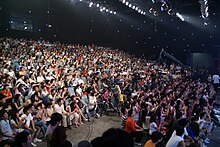Studio audience
This article relies largely or entirely on a single source. (March 2020) |

A studio audience is an audience present for the recording of all or part of a television program or radio program. The primary purpose of the studio audience is to provide applause and/or laughter to the program's soundtrack (as opposed to canned laughter). Additionally, live studio audiences produce an energy off of which the actors can feed, as well as push actors to perform to the best of their abilities. Unlike relying on the ideal chuckles that a laugh track consistently provides, actors have to work for the laughs. A studio audience can also provide volunteers, a visual backdrop and discussion participants.
In some cases, a studio audience can be called upon to vote, to help a contestant(s) (such as with Who Wants to Be a Millionaire?) or pass judgment on a politician (such as with Question Time).
In the United States, tickets to be a part of a studio audience are usually given away. However, as an enticement to attend, one or more members of the audience may be selected to win a prize, which is usually provided by a manufacturer in exchange for an advertisement, usually at the end of the show. Some game shows, such as Let's Make a Deal and The Price is Right, select contestants directly from the studio audience.
For sitcom/sketch comedy shows like All in the Family, Saturday Night Live and Happy Days (for indoor scenes), the use of a live studio audiences essentially turns them into de facto stage productions while shooting individual scenes, with minor problems like the audience applauding or uproariously whooping (the latter since becoming a satirical cliché in shows which mock the format and tropes of traditional sitcoms) when their favorite performers enter the stage. Shows like The Red Green Show, meanwhile, actually make the audience a part of the show, since that show is supposedly a television broadcast made from the (fictional) Possum Lodge, cast members react and speak directly to the audience as if they were talking to the viewers at home.
History[]
Most early radio shows in the United States were recorded in the presence of a studio audience, including comedies such as The Jack Benny Program, The Phil Harris-Alice Faye Show, and Fibber McGee and Molly, as well as anthology series like The Mercury Theatre and Lux Radio Theatre.
In its earliest days, most television broadcasts stemmed from the world of New York theater.[1] Stage veterans were experienced in performing for a crowd. Starting in the 1940s, these plays were broadcast live.[1] Thus, these plays were now directed towards both the live audience and those watching from home.
Premiering in 1951, I Love Lucy was the first television series to be filmed in front of an audience.[1] This was made possible by the idea of Desi Arnaz to use multi-camera setup, a concept which had been pioneered by Jerry Fairbanks, and which had been used on The Silver Theater, Truth or Consequences and Amos ‘n’ Andy. This implementation allowed the show to benefit from the strengths of both stage plays (live audience) and film (camera angle options, point of view, etc.).[1] This approach produced a marriage between cinema and theater; television and plays. This approach was subsequently adopted by most U.S. network sitcoms until the 2000s, when one characteristic of that era's Golden Age of Television was a resurgence in single-camera setup sitcoms without studio audiences, although studio-audience sitcoms continued to be made.
Although radio broadcasts for a studio audience have for the most part ended for commercial radio programs (outside of special "road show" episodes), public radio shows such as A Prairie Home Companion, Wait Wait... Don't Tell Me!, Says You!, Tent Show Radio and Whad'Ya Know? are mainly performed in front of live audiences in theaters or art centers, if not a confined studio setting.
Due to the COVID-19 pandemic, a large number of television programs have been forced to conduct tapings without live audiences due to restrictions on gatherings. Some shows usually filmed in front of a studio audience used canned applause and laugh tracks instead,[2] in some cases accompanied by stock footage of audiences from previous episodes filmed prior to pandemic restrictions.[3][4][5] Some shows—particularly talk shows, game shows, and reality competitions—have adopted virtual audiences, whereby audience members appear from their homes via webcams and videoconferencing.[6][7][8]
References[]
- ^ a b c d VanDerWerff, Emily. "Do Sitcoms Taped Before a Studio Audience Have a Future?". A.V. Club.
- ^ Lopez, Kristen (2020-09-30). "'The Conners' Will Exclude Live Audiences for the Foreseeable Future". IndieWire. Retrieved 2021-08-21.
- ^ White, Peter (2020-09-21). "'The Masked Singer': Fox's Rob Wade On How The Mystery Singing Competition Got Back On Stage". Deadline. Retrieved 2020-09-21.
- ^ "'The Masked Singer' Pulled Off Its Pandemic Season With Animation, Fan Voting and a Baby Alien". TheWrap. 2020-09-21. Retrieved 2020-10-07.
- ^ Keegan, Kayla (2021-06-02). "'AGT' Fans Are Tweeting Up a Storm About Season 16's Audience During the Audition Round". Good Housekeeping. Retrieved 2021-07-14.
- ^ Bickerton, Jake. "Saturday Night Takeaway gets Virtual Interactive Audience". Broadcast. Retrieved 2021-08-21.
{{cite web}}: CS1 maint: url-status (link) - ^ Dachman, Jason. "The Famous Group Blazes Virtual-Fan Trail With New WWE, US Open Integrations". Sports Video Group. Retrieved 2021-08-21.
{{cite web}}: CS1 maint: url-status (link) - ^ Del Rosario, Alexandra (2020-10-29). "'The Ellen DeGeneres Show' Welcomes Back Limited, Masked Live Studio Audience". Deadline. Retrieved 2020-11-10.
- Television terminology